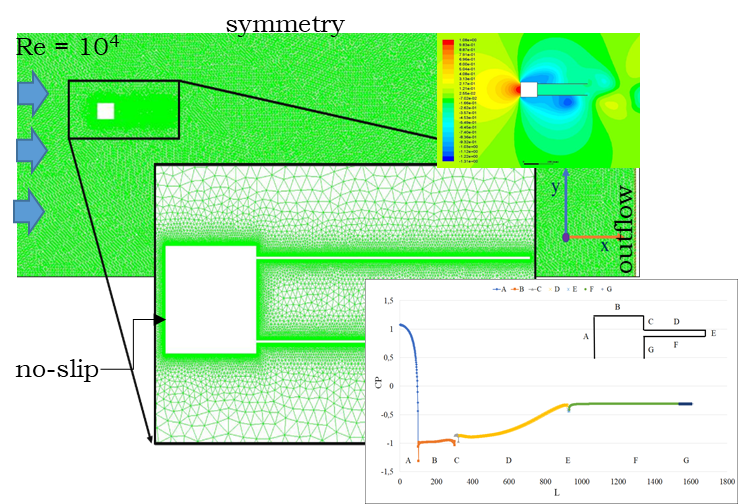Pengaruh Kendali Turbulensi Aliran terhadap Bidang Aliran Di Sekitar Struktur Persegi
DOI:
https://doi.org/10.55679/pistonjt.v8i1.42Kata Kunci:
Pemisah aliran, Gaya-gaya fluida, Tekanan, Deformasi Aliran, Model turbulen k - εAbstrak
Karakteristik aliran yang melewati struktur mempengaruhi stabilitas, desain aerodinamika dan respon struktur terhadap pola aliran yang melewatinya. Penelitian ini mengkaji secara numerik efek penggunaan pemecah aliran (splitter plate) terhadap pola kecepatan, tekanan, gaya aerodinamis dan deformasi aliran pada bilangan Reynolds 104. Penelitian ini menggunakan pemecah aliran tipe ganda 2D di sisi hilir dengan model turbulen k-ε menggunakan perangkat lunak ANSYS FLUENT 18.2. Hasil simulasi numerik menunjukkan bahwa penggunaan spliter plate telah merubah pola aliran yang melewati silinder persegi yang ditandai dengan berkurangnya zona negative aliran, pemulihan tekanan, dan penurunan gaya hambat. Pola deformasi aliran berbeda dengan silinder tanpa splitter plate. Data-data numerik juga ditampilkan dalam bentuk kontur aliran untuk memverikasi data grafis yang ditunjukkan pada studi ini. Studi ini juga menunjukkan bahwa penggunaan splitter plate juga menunjukkan sesintifitas grid yang berbeda dengan silinder persegi biasa, sehingga uji validasi-verifikasi sensitifitas grid silinder dengan splitter plat tidak direkomendasikan pada kasus yang serupa.
Unduhan
Referensi
A. Abdelkefi, “Aeroelastic energy harvesting: A review”, International Journal of Engineering Science, Vol. 100, 2016, pp 112-135. https://doi.org/10.1016/j.ijengsci.2015.10.006.
L. O. A. Barata, K. Takahiro, T. Ueno, S. Samhuddin, and L. Hasanudin, "Experimental Investigation of Bladeless Power Generator from Wind-induced Vibration," International Journal of Renewable Energy Development, vol. 11, no. 3, pp. 661-675, Aug. 2022.
https://doi.org/10.14710/ijred.2022.43888
H. Park, A. P. Mentzelopoulos, M. M. Bernitsas, “Hydrokinetic energy harvesting from slow currents using flow-induced oscillations”, Renewable Energy, Vol. 214, 2023, pp 242-254,October 2021. https://doi.org/10.1016/j.renene.2023.05.110.
Guo, G. Wu, X. Du, M. S. Mason, “Numerical investigation of flow around a square cylinder in accelerated flow. Physics of Fluids 1 vol.33 (10), 104105, October 2021. https://doi.org/10.1063/5.0062282
X. Liu, F. Huang, F. Xu, Z. Duan, J. Ou, "Numerical study on wake control of square cylinder based on vertical axis wind turbines”, Journal of Building Engineering, Vol. 68, 106203, June 2023. https://doi.org/10.1016/j.jobe.2023.106203.
L. O. A. Barata, E. Ngii, T. Kiwata, and T. Kono, “Enhancing Dynamic Response of Cantilevered Rectangular Prism Using a Splitter Plate as a Passive Turbulence Control in Water Tunnel,” J. Adv. Res. Fluid Mech. Therm. Sci., vol. 91, no. 2, pp. 1–14, Feb. 2022. https://doi.org/10.37934/arfmts.91.2.114
Hwang, Jong-yeon, & K. Yang, "Drag Reduction on a Circular Cylinder Using Dual Detached Splitter Plates", Journal of Wind Engineering and Industrial Aerodynamics 95, pp. 551–564, 2007. https://doi.org/10.1016/j.jweia.2006.11.003
W. L. Oberkampf and M. F. Barone, “Measures of agreement between computation and experiment: Validation metrics,” J. Comput. Phys., vol. 217, no. 1, pp. 5–36, Sep. 2006.
W. L. Oberkampf and T. G. Trucano, “Verification and validation in computational fluid dynamics,” Prog. Aerosp. Sci., vol. 38, no. 3, pp. 209–272, Apr. 2002.
M. F. White, Fluid Mechanics-Eighth edition. McGraw Hill Education, 2016.
H. Versteeg and W. Malalasekera, Introduction to Computational Fluid Dynamics, 2nd ed. Pearson Education Limited, 2010.
ANSYS, ANSYS Fluent 18.1. Theory Guide, ANSYS, Inc, 2017.
S.Mizukami, "Study on the Flow around the Elastic Supported Prism and the Vibration Dynamics of the Flow (in Japanese)," Master Thesis, Graduate School of Natural Science and Technology, Kanazawa University, 2017.
D.Yu, K. Butler, A. Kareem, J. Glimm, and J. Sun, "Simulation of the Influence of Aspect Ratio on the Aerodynamics of Rectangular Prisms", Journal of Engineering Mechanics 139, no. 4, pp. 429–438, 2013. https://doi.org/10.1061/(ASCE)EM.1943-7889.0000494.
C. W. Knisely, "Strouhal Numbers of Rectangular Cylinders at Incidence: A Review and New Data," Journal of Fluids and Structures 4, no. 4, pp. 371–393, 1990. https://doi.org/10.1016/0889-9746(90)90137-T.
P W Bearman, and D M Trueman, "An Investigation of the Flow around Rectangular Cylinders," Aeronautical Quarterly 23, no. 3 pp.229–237, 1972. https://doi.org/10.1017/S0001925900006119
L. O. A. Barata, T. Kiwata, A. Rachman, Samhuddin, and nanang endriatno, “Numerical Investigation of Flow Around Finite Height Rectangular”, CFD Lett., vol. 15, no. 6, pp. 154–175, Apr. 2023. https://doi.org/10.37934/cfdl.15.6.154175

Unduhan
Diterbitkan
Cara Mengutip
Terbitan
Bagian
Lisensi
Hak Cipta (c) 2023 Piston: Jurnal Teknologi

Artikel ini berlisensi Creative Commons Attribution-NonCommercial 4.0 International License.










